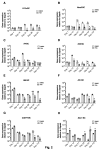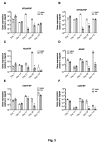Treatment of autoimmune encephalomyelitis with a histone deacetylase inhibitor
- PMID: 37283668
- PMCID: PMC10240938
- DOI: 10.17879/freeneuropathology-2020-2819
Treatment of autoimmune encephalomyelitis with a histone deacetylase inhibitor
Abstract
We have previously shown that treatment of female NOD mice with a potent nonselective histone deacetylase inhibitor attenuated experimental autoimmune encephalomyelitis, a model for progressive multiple sclerosis. Herein we show that immunization with the MOG35-55 peptide induced prolonged upregulation of genes encoding interleukin 17A (IL-17A), aryl hydrocarbon receptor, and histone deacetylase 11 in the spinal cord whereas the subunits of IL-27, IL-27p28 and IL-27ebi3 were significantly increased in secondary lymphoid organs after a lag period. Interestingly, the nitric oxide synthase gene was prominently expressed in both of these anatomic compartments following immunization. Treatment with the histone modifier repressed the transcription of all of these genes induced by immunization. Moreover, the drug suppressed the steady-state levels of the migration inhibitory factor and CD274 genes in both the spinal cord and peripheral lymphoid tissues. At the same time, the CD39 gene was downregulated only in secondary lymphoid organs. Paradoxically, the epigenetic drug enhanced the expression of Declin-1 in the spinal cord, suggesting a protective role in neuronal disease. Immunization profoundly enhanced transcription of the chemokine CCL2 in the secondary lymphoid tissues without a corresponding increase in the translation of CCL2 protein. Histone hyperacetylation neither altered the transcription of CCL2 nor its cognate receptor CCR2 in the central nervous system and peripheral lymphoid tissues. Surprisingly, the drug did not exert modulatory influence on most other immune response-related genes previously implicated in encephalomyelitis. Nevertheless, our data uncover several potential molecular targets for the intervention of experimental autoimmune encephalomyelitis that have implications for the treatment of progressive multiple sclerosis.
Keywords: Autoreactive T cells; Epigenetic regulation; Experimental autoimmune encephalomyelitis; Gene expression; Multiple sclerosis; Trichostatin A.
Figures





Similar articles
-
The epigenetic drug Trichostatin A ameliorates experimental autoimmune encephalomyelitis via T cell tolerance induction and impaired influx of T cells into the spinal cord.Neurobiol Dis. 2017 Dec;108:1-12. doi: 10.1016/j.nbd.2017.07.015. Epub 2017 Jul 20. Neurobiol Dis. 2017. PMID: 28736194
-
Amelioration of progressive autoimmune encephalomyelitis by epigenetic regulation involves selective repression of mature neutrophils during the preclinical phase.Exp Neurol. 2018 Jun;304:14-20. doi: 10.1016/j.expneurol.2018.02.008. Epub 2018 Feb 14. Exp Neurol. 2018. PMID: 29453977
-
Physical Exercise Attenuates Experimental Autoimmune Encephalomyelitis by Inhibiting Peripheral Immune Response and Blood-Brain Barrier Disruption.Mol Neurobiol. 2017 Aug;54(6):4723-4737. doi: 10.1007/s12035-016-0014-0. Epub 2016 Jul 22. Mol Neurobiol. 2017. PMID: 27447807
-
MicroRNAs as disease progression biomarkers and therapeutic targets in experimental autoimmune encephalomyelitis model of multiple sclerosis.Neural Regen Res. 2020 Oct;15(10):1831-1837. doi: 10.4103/1673-5374.280307. Neural Regen Res. 2020. PMID: 32246624 Free PMC article. Review.
-
Genetic and Epigenetic Regulation of the Innate Immune Response to Gout.Immunol Invest. 2023 Apr;52(3):364-397. doi: 10.1080/08820139.2023.2168554. Epub 2023 Feb 6. Immunol Invest. 2023. PMID: 36745138 Review.
Cited by
-
Impact of histone modifier-induced protection against autoimmune encephalomyelitis on multiple sclerosis treatment.Front Neurol. 2022 Oct 14;13:980758. doi: 10.3389/fneur.2022.980758. eCollection 2022. Front Neurol. 2022. PMID: 36313502 Free PMC article. Review.
-
Epigenetic modulation of selected immune response genes and altered functions of T lymphocytes and macrophages collectively contribute to autoimmune diabetes protection.BBA Adv. 2021 Nov 11;1:100031. doi: 10.1016/j.bbadva.2021.100031. eCollection 2021. BBA Adv. 2021. PMID: 37082012 Free PMC article.
-
Superscan Pattern on Bone Scintigraphy: A Comprehensive Review.Diagnostics (Basel). 2024 Oct 6;14(19):2229. doi: 10.3390/diagnostics14192229. Diagnostics (Basel). 2024. PMID: 39410633 Free PMC article. Review.
References
LinkOut - more resources
Full Text Sources
Research Materials
